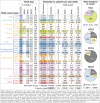RAS variant signalling
- PMID: 30287508
- PMCID: PMC6195641
- DOI: 10.1042/BST20180173
RAS variant signalling
Abstract
RAS proteins are small GTPases that regulate signalling networks that control cellular proliferation and survival. They are frequently mutated in cancer and a commonly occurring group of developmental disorders called RASopathies. We discuss recent findings describing how RAS isoforms and different activating mutations differentially contribute to normal and disease-associated biology and the mechanisms that have been proposed to underpin this.
Keywords: RAS; cancer; codon; isoforms; mutation; signalling.
© 2018 The Author(s).
Conflict of interest statement
The Authors declare that there are no competing interests associated with the manuscript.
Figures


References
Publication types
MeSH terms
Substances
Grants and funding
LinkOut - more resources
Full Text Sources

